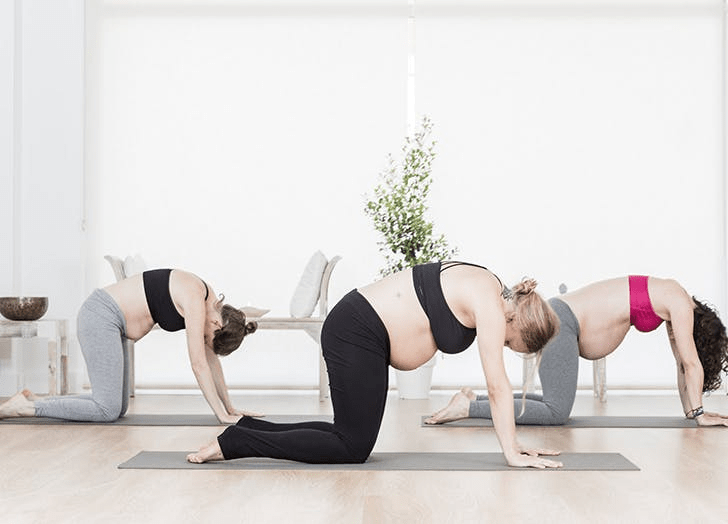Every expectant mother experiences an amazing journey as she welcomes a new life into the world. Joy, excitement, anticipation, and, of course, physical and emotional changes are all part of a women’s pregnancy journey. Taking care of a woman’s mind and body becomes even more important in the midst of this beautiful transformation. Pregnancy yoga is a wonderful practice that can help with this amazing transformation. In this blog, we will discuss how pregnancy yoga provides a way to wellness during the pregnancy phase by providing a holistic approach to support and nurture both the mother and baby.
- Embracing Physical Wellbeing: Pregnancy yoga focuses on gentle stretching, strengthening, and toning exercises designed specifically for the pregnant body. Through carefully designed poses, it helps alleviate common discomforts such as back pain, swollen ankles, and sciatica. By participating in regular yoga practice, mothers-to-be can improve circulation, maintain flexibility, and improve overall physical well-being, laying the foundation for a healthy pregnancy.
- Cultivating Emotional Balance: Pregnancy brings a mix of emotions ranging from excitement to anxiety. Pregnancy yoga helps expectant mothers to connect with their emotions, reduce stress, and find the inner calm. Breathing techniques and meditation practices in pregnancy yoga classes help in soothing the mind, releases the tension, and creates a sense of emotional balance. It empowers expectant mothers with tools to navigate the emotional ups and downs, creating a serene and positive mindset.
- Bonding with Baby: Pregnancy yoga nurtures the bond between mother and baby. Through gentle movements and focused awareness, expectant mothers can establish a deep connection with their growing bump. It is a time for mindfulness and communication with the unborn child, fostering a sense of closeness and love. The practice also encourages relaxation and visualization techniques that assist in creating a peaceful environment for both mother and baby.
- Building a Supportive Community: Attending pregnancy yoga classes offers a unique opportunity to connect with other expectant mothers. Sharing this transformative journey with like-minded individuals can provide a sense of belonging and support. It becomes a space to exchange experiences, seek advice, and build lasting friendships. The bond formed within these classes extends beyond the practice, creating a network of understanding and encouragement.
- Enhancing Postural Alignment and Core Strength: During pregnancy, the body undergoes significant changes, including shifts in the center of gravity and the stretching of abdominal muscles. Pregnancy yoga focuses on improving postural alignment and strengthening the core muscles to support the changing body. By incorporating gentle poses that target the back, hips, and pelvic floor, it helps alleviate strain on the spine, promotes better posture, and prepares the body for the demands of labor and postpartum recovery.
- Promoting Relaxation and Better Sleep: Restful sleep becomes crucial during pregnancy, but discomfort and hormonal changes can sometimes disrupt it. Pregnancy yoga incorporates relaxation techniques, such as guided imagery and gentle stretching, that promote deep relaxation and help alleviate insomnia or restlessness. By calming the mind and relaxing the body, expectant mothers can enjoy more rejuvenating sleep, which is essential for their overall well-being and the healthy development of the baby.
- Empowering the Birth Experience: Pregnancy yoga equips women with valuable tools and techniques to navigate the journey of labor and childbirth. Through breathwork, visualization, and practicing birthing positions, expectant mothers can enhance their ability to cope with contractions, manage pain, and cultivate a sense of empowerment during labor. The mindfulness cultivated in pregnancy yoga also encourages women to trust their bodies and embrace the innate wisdom of childbirth, fostering a positive and empowering birth experience.
- Postpartum Recovery and Rejuvenation: The benefits of pregnancy yoga extend beyond pregnancy and into the postpartum period. After giving birth, the body undergoes further changes as it heals and adjusts. Engaging in postnatal yoga, which builds upon the principles of pregnancy yoga, can support the body’s recovery process, strengthen the pelvic floor, and improve overall energy levels. It offers a gentle transition back to exercise and helps mothers reconnect with their bodies after the transformative experience of childbirth.
- Alleviating Pregnancy Discomforts: Pregnancy often brings with it various discomforts such as nausea, swollen joints, and muscle tension. Pregnancy yoga can provide much-needed relief by incorporating gentle stretches, relaxation techniques, and breathwork specifically targeted to address these common discomforts. The gentle movements and poses help improve circulation, reduce swelling, and release tension, allowing expectant mothers to find comfort and ease during this transformative phase. By alleviating physical discomforts, pregnancy yoga promotes a sense of well-being and enhances the overall pregnancy experience.
Pregnancy yoga is a powerful and reassuring practice that promotes expectant mothers’ holistic health. It supports the physical, emotional, and spiritual aspects of pregnancy by combining gentle physical exercises, emotional balance, and bonding strategies. Pregnancy yoga not only helps women have a healthy and happy pregnancy, but it also gives them the tools they need for labor, childbirth, and the beginning stages of motherhood. Take advantage of pregnancy yoga’s transformative power and embark on a journey of wellness, connection, and self-discovery as you care for your beautiful bump.
Note: Remember, always consult with your healthcare provider before starting any new exercise routine during pregnancy.

As the editor of the blog, She curate insightful content that sparks curiosity and fosters learning. With a passion for storytelling and a keen eye for detail, she strive to bring diverse perspectives and engaging narratives to readers, ensuring every piece informs, inspires, and enriches.










